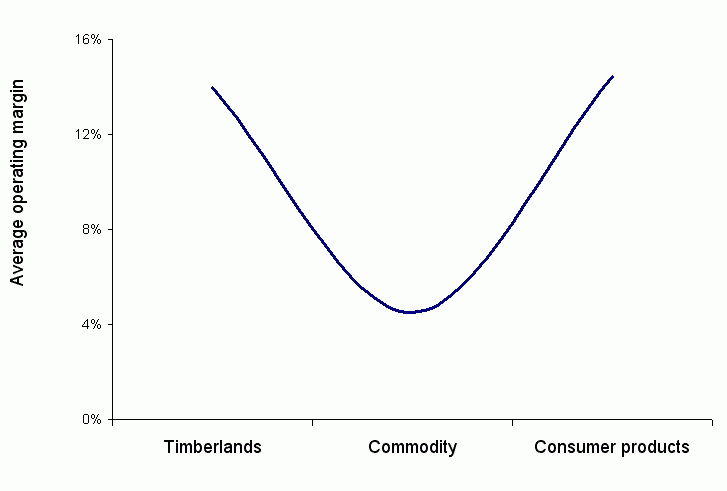Selective Cuttings
Structural changes in the Canadian forest sector
July 19, 2013
The current era of the Canadian forest sector is characterized by transformation: radical, intentional change. Most thinking around of these changes has focused on developing new products, environmental performance, and market development. In the long-run, however, changes in the ownership structure of the sector, and the business plans which characterize its constituent firms, could be even more important.
Historically, the Canadian forest sector has been characterized by vertically and horizontally integrated firms that dominate operations on a regional or provincial basis. The relatively high capital costs of pulp and paper facilities, economies of scale, tight supply chains between lumber and pulp production and steady growth in paper consumption reinforced this industrial organization. Over the past decade, however, a changing business environment has broken these relationships down. First, growing fibre scarcity world-wide has raised fibre costs—decreasing operating margins for commodity production while increasing margin for timberland owners. Second, decreased barriers to trade (institutional and economic) have globalized supply chains. Third, rapid growth in demand for secondary pulp and paper products (such as hygiene products, tissues, toilet paper, containerboard and textiles) has increased operating margins for consumer products. Fourth, rapid growth in the supply of commodity pulp from tropical countries has kept pulp prices relatively low. This has had a significant impact on operating margins.
Average operating margin by sector in the Canadian forest industry (1999-2012)
In the above figure, “commodity” products include lumber, panels, pulp and graphic paper, while “consumer products” include tissues, packaging and specialty papers. In this economic environment, there is a strong incentive for previously vertically integrated firms to move out of commodity production and specialize in either timberland management, or secondary products. Some of the largest global forest firms have already done this. Domtar is the latest firm that has signalled it is strategically acquiring consumer goods firms to find higher margin products with better growth prospects. Domtar has divested itself of its entire solid wood segment as well as some market pulp mills, while acquiring pulp based personal care (e.g. feminine hygiene products, diapers, adult incontinence products, etc) production and distribution firms, as well as moving decisively closer to customers for their office papers through major investment in distribution networks.
Into this environment, multi-national Asian conglomerates have been accumulating market pulp mills in Canada to integrate into international supply chains. Their goals for these assets are different than traditional market pulp companies. With very large domestic profits from Asian textile and tissue production, these firms are focused on securing cost and supply certainty in sourcing their input pulp needs. For example, Paper Excellence (a wholly owned subsidiary of Indonesian conglomerate Sinar Mas) had no Canadian operations until 2007, but has become the largest producer of Northern Bleached Softwood Kraft pulp in Canada. Similarly, Aditya Birla entered Canada in 2006, and is now the largest producer of dissolving pulp. Both firms remain active in seeking new acquisitions, while investing hundreds of millions of dollars in upgrades and conversions – primarily of previously idled mills.
Meanwhile, traditional commodity producers have become increasingly specialized, focusing on a particular commodity which they identify as their “core” activity. Much of this movement has been a response to the collapse of graphic paper demand (both in North America, and increasingly world-wide). On the solid wood side, the on-going recovery of the U.S. housing sector combined with decreasing fibre availability in Interior B.C. and Quebec has significantly increased expectations for returns to structural lumber and panels production over the next decade. This has prompted a wave of acquisitions by large Canadian softwood lumber firms (particularly West Fraser, Canfor and Interfor) in the U.S. South, where the long-run fibre supply is closer to market, competitively priced, and more stable.
The implications of this radical change in ownership structure and firm strategic direction are profound, and in the long-run, perhaps no other transformation will have as significant impact on the future of the Canadian forest sector.

